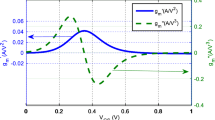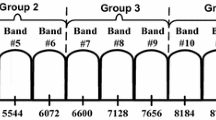Abstract
The scaling of CMOS technology has greatly influenced the design of analog and radio-frequency circuits. In particular, as technology advances, due to the use of lower supply voltage the available voltage headroom is decreased. In this paper, after a brief overview of conventional low-power CMOS active mixer structures, we introduce an active mixer structure with sub-mW-level power consumption that is capable of operating from a supply voltage comparable or lower than the threshold voltage of the transistor. In addition, the proposed architecture provides a performance and conversion gain (CG) that compares favorably or exceeds those of the state-of-the-art designs. As a proof-of-concept, a wide-band DC to 8.5 GHz down-conversion mixer is designed and fabricated in a 90-nm CMOS process. Measurement results show that the mixer achieves a CG as high as 18 dB while consuming 98 μW from a 0.3-V supply.
































Similar content being viewed by others
Notes
The list of these publications is available at http://www.ece.ubc.ca/~amirms/mixer-trend.xlsx
References
Behzad R. (2012). RF Microelectronics (2nd ed.). Prentice Hall: Englewood Cliffs.
Han, G., & Sanchez-Sinencio, E. (1998). CMOS transconductance multipliers: A tutorial. IEEE Transactions on Circuits and Systems II: Analog and Digital Signal Processing, 45(12), 1550–1563.
Kan, K., Ma, D., & Luong, H. (2000). Design theory and performance of 1-GHz CMOS downconversion and upconversion mixers. Analog Integrated Circuits and Signal Processing, 24(2), 101–111.
Lee, H., & Mohammadi, S. (2007). A 500 μW 2.4 GHz CMOS Subthreshold Mixer for Ultra Low Power Applications. In IEEE Radio Frequency Integrated Circuits (RFIC) Symposium (pp. 325–328) 3–5 June 2007.
Masnadi Shirazi, A. H., & Mirabbasi, S. (2012). An ultra-low-voltage CMOS mixer using switched-transconductance, current-reuse and dynamic-threshold-voltage gain-boosting techniques. In IEEE 10th NEWCAS, 2012 (pp. 393–396) 17–20 June 2012.
Klumperink, E. A. M., Louwsma, S.M., Wienk, G. J. M., & Nauta, B. (2004). A CMOS switched transconductor mixer. IEEE Journal of Solid-State Circuits, 39(8), 1231–1240.
Terrovitis, M.T., & Meyer, R.G. (1999). Noise in current-commutating CMOS mixers. IEEE Journal of Solid-State Circuits, 34(6), 772–783.
Assaderaghi, F., Sinitsky, D., Parke, S. A., Bokor, J., Ko, P. K., & Hu, C. (1997). Dynamic threshold-voltage MOSFET (DTMOS) for ultra-low voltage VLSI . IEEE Transactions on Electron Devices, 44(3), 414–422.
Lee, S. -G. & Choi, J. -K. (2000). Current-reuse bleeding mixer. Electronics Letters, 36(8), 696–697.
Im, D., Nam, I., Kim, H. -T, & Lee, K. (2009). A wideband CMOS low noise amplifier employing noise and IM2 distortion cancellation for a digital TV tuner. IEEE Journal of Solid-State Circuits, 44(3), 686–698.
Nam, I., Kim, B., & Lee, K. (2005). CMOS RF amplifier and mixer circuits utilizing complementary characteristics of parallel combined NMOS and PMOS devices. IEEE Transactions on Microwave Theory and Techniques, 53(5), 1662–1671.
Parvizi, M. & Nabavi, A. (2009). Improved derivative superposition scheme for simultaneous second- and third-order distortion cancellation in LNAs. Electronics Letters, 45(25), 1323–1325.
Galal, A. I. A., Pokharel, R., Kanaya, H., & Yoshida, K. (2012). High linearity technique for ultra-wideband low noise amplifier in 0.18 μm CMOS technology. International Journal of Electronics and Communications, 66, 12–17.
Webster, D. R., Haigh, D. G., Scott, J. B., & Parker, A. E. (May 1996). Derivative superposition-a linearization technique for ultra broadband systems. IEE Colloquium Wideband Circuits, Modeling and Techniques, 3/1–3/14.
Vidojkovic, V., et al. (2006). A low-voltage folded-switching mixer in 0.18-μm CMOS. IEEE Journal of Solid-State Circuits, 40, 1259–1264.
He, S., & Saavedra, C. E. (2012). An ultra-low-voltage and low-power 2 subharmonic downconverter mixer. IEEE Transactions on Microwave Theory and Techniques, 60(2), 311–317.
Acknowledgments
This research is supported in part by the Natural Sciences and Engineering Research Council (NSERC) of Canada. CAD tools and access to technology are facilitated by CMC Microsystems. The authors would also like to thank Dr. Roberto Rosales and Hooman Rashtian for their technical assistance, and Roozbeh Mehrabadi for CAD tool support.
Author information
Authors and Affiliations
Corresponding author
Rights and permissions
About this article
Cite this article
Shirazi, A.H.M., Mirabbasi, S. An ultra-low-voltage ultra-low-power CMOS active mixer. Analog Integr Circ Sig Process 77, 513–528 (2013). https://doi.org/10.1007/s10470-013-0163-2
Received:
Revised:
Accepted:
Published:
Issue Date:
DOI: https://doi.org/10.1007/s10470-013-0163-2




